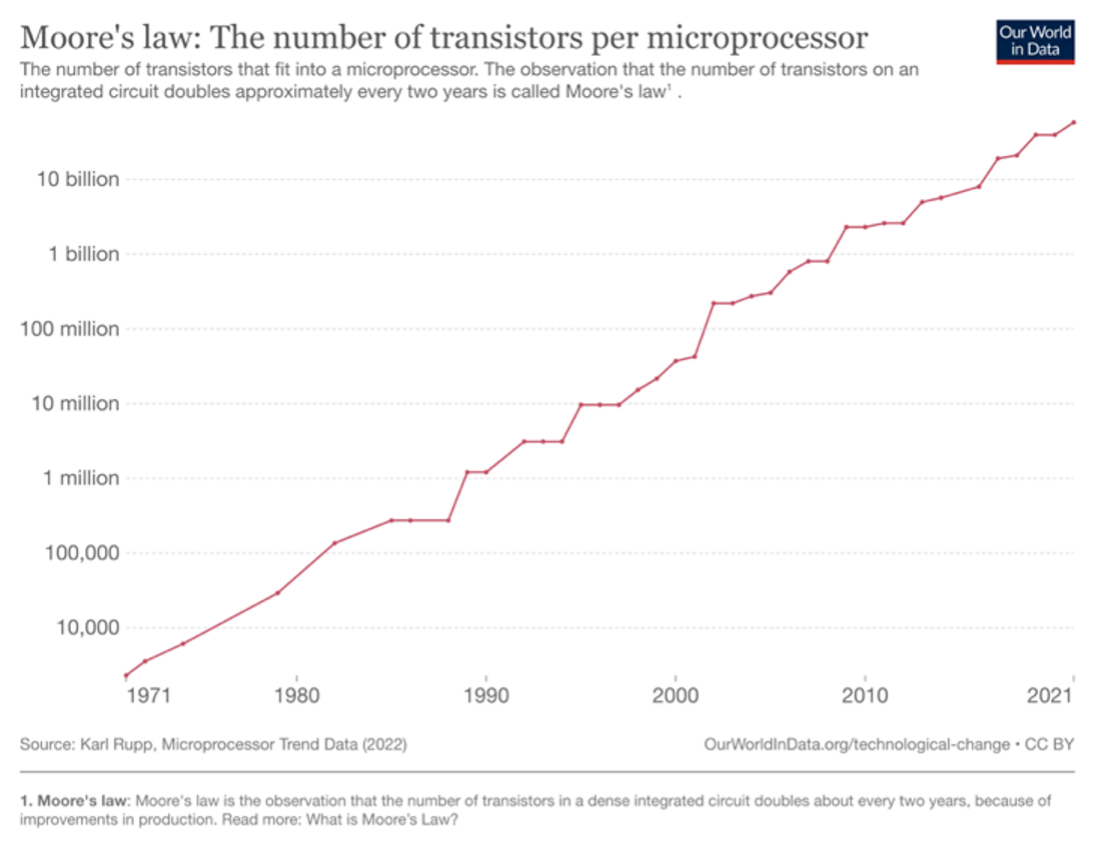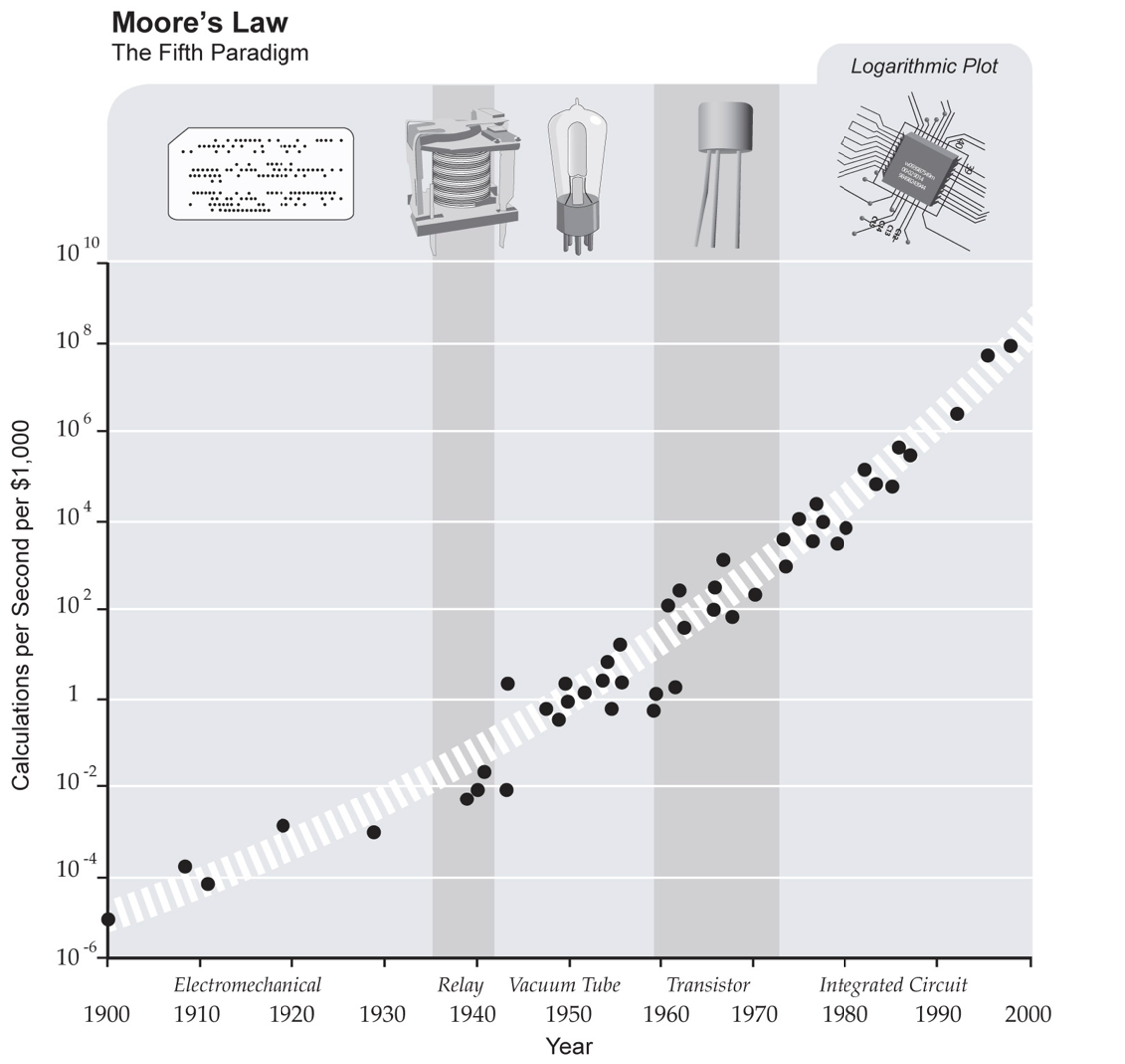
You’ve no doubt heard of Moore’s Law. But do you know its history and exactly how it works?
Almost all of the developments in the exponential tech world are built on ever-increasing computational power, which is in turn driving the speed of AI, robotics, biotech, and VR.
For the past 60+ years, Moore’s Law, the exponential growth of computing power, has continued nonstop. But to truly appreciate the impact of Moore’s Law, it helps to understand its origins.
That’s what today’s blog is all about.
Let’s dive in…
Moore’s Law Continues…
In 1965, Gordon Moore (a co-founder of Intel) published a paper observing that between 1959 and 1965, the number of transistors on an integrated circuit had been doubling roughly every 18 to 24 months. He projected this would continue for some time.
This concept has held true for several decades and has become known as "Moore's Law."
The chart below, plotted on a log scale, demonstrates this trend:

Here’s a historical example to illustrate the power (and accuracy) of Moore’s Law. In 1971, Intel came out with its first commercial product, a 4-bit CPU called the Intel 4004 integrated circuit. The 4004 had 2,300 transistors with a gate length of 10,000 nanometers, and computer power of about 740 KHz.
By this time, each transistor cost about $1, on average.
Today, the cost of a single transistor is about 1 billion times less than it was in the 1970s, and you can fit a staggering number of them on a single chip. For example, in 2022 NVIDIA released its RTX 4090 graphic processing unit (GPU), which consists of 76 billion transistors. And that’s not even the most powerful chip on the market. Apple’s M1 Ultra boasts an incredible 114 billion transistors.
In just 50 years, the technology experienced a 100-billion-fold improvement, right on schedule for Moore's Law.
Here’s a quote from Moore himself I absolutely love that captures the significance of this trend:
“If the auto industry advanced as rapidly as the semiconductor industry, a Rolls Royce would get half a million miles per gallon, and it would be cheaper to throw it away than to park it.”
But Moore's Law only describes computational growth utilizing integrated circuits.
The Law of Accelerating Returns
In his most excellent book The Singularity Is Near, Ray Kurzweil described exponential growth in computation during a period predating the integrated circuit, over the past 120+ years.
Kurzweil points out that computation has gone through five different paradigms, the last of which we know as “Moore’s Law”:
- 1st Paradigm: Electromechanical computers
- 2nd Paradigm: Relay-based computers
- 3rd Paradigm: Vacuum-tube-based computers
- 4th Paradigm: Transistor-based computers
- 5th Paradigm: Integrated circuits (Moore’s Law)
Moore's Law (the 5th paradigm of computation) is therefore a subset of a much broader exponential principle described by Kurzweil's “Law of Accelerating Returns.”

Why This Matters
Earlier in this series, we looked at how much the world has changed over the past 500 or so years.
The scope and speed of these sweeping changes is nothing less than breathtaking.
Because of accelerating tech advancements and the continued influence of forces like Moore’s Law and the 6Ds, the world is getting more abundant all the time on many critical fronts. Changes across dozens of areas have driven us towards increasing abundance—“up and to the right”—at a profound rate.
I call this “data-driven optimism” and it’s one of the key reasons to be optimistic about the future.
Over the next few blogs, we’ll look at evidence of abundance—from declining poverty and child mortality rates, to increasing voting rights and literacy.
I wanted to take a second to tell you about a company I'm personally invested in and that is a part of my personal health optimization: Seed Health, a microbiome science company that is doing incredible research (which you’ll hear more about from me and on the podcast in the coming months). Seed is most known for their innovations and clinical research in probiotics—especially DS-01®, which I take and believe is the best probiotic available.
Unlike our genome, our gut microbiome is one of the most important levers of health given its connectivity to almost every biological function and organ system. How can you optimize your gut health? In addition to diet and other lifestyle choices, here’s what I do:
Every day, I take two capsules of Seed’s DS-01® Daily Synbiotic: a broad spectrum 2-in-1 probiotic and prebiotic formulated with 24 genetically distinct clinically- and scientifically-studied probiotic strains and a polyphenol-based prebiotic.
Developed from a deep understanding of the complex interactions within the microbiome, DS-01® confers benefits in and beyond the gut. This novel synbiotic preserves ecosystem function, fortifies the gut barrier, promotes healthy regularity, reinforces an optimal gut-skin axis, promotes cardiovascular health, and supports healthy immunological responses in the GI tract.
The specific prebiotic is sourced from the skin of Indian pomegranate and has also been clinically validated to support healthy aging, including the reduction of aging markers like the appearance of wrinkles. Unlike most fiber-based prebiotics, Seed’s is non-fermenting which makes it gentler on the stomach and tolerable for a FODMAP diet.
In contrast with most probiotics, DS-01® is engineered to survive with Seed’s patented capsule-in-capsule ViaCap® technology that optimizes viability and delivers a precision release to the colon, where it matters most. This technology also ensures stability, so there’s no refrigeration required.
Known for their renowned scientists in the field of microbiome and probiotics, Seed’s scientific rigor and ongoing research have set them apart from others. DS-01® strains have been clinically studied in over 20 clinical and mechanistic studies. Two clinical trials evaluating the DS-01® formulation have recently been completed: one assessing the impact of DS-01® on patients with Irritable Bowel Syndrome (IBS) under Investigational New Drug authorization from the FDA; and another evaluating the effects of DS-01® on the gut microbiota during and after antibiotic usage (under Health Canada authorization). This new data is anticipated to be published in high-impact scientific journals in the coming six months.
I value Seed's scientific rigor and the company's work. This is why I believe DS-01® is so effective and has become the probiotic of choice not just for me, but for so many other people I respect.
As part of my mission to help my community optimize their health, we’ve worked with Seed to create a code for our readers. Use code PETER25 for 25% off your first month of Seed’s DS-01®.
I discuss topics just like this on my podcast. Here’s a conversation I recently enjoyed:
A Statement From Peter:
My goal with this newsletter is to inspire leaders to play BIG. If that’s you, thank you for being here. If you know someone who can use this, please share it. Together, we can uplift humanity.
Topics: Abundance Entrepreneurship Abundance 360 a360








